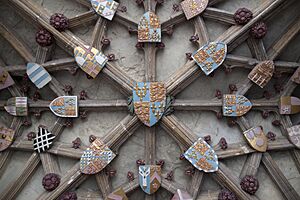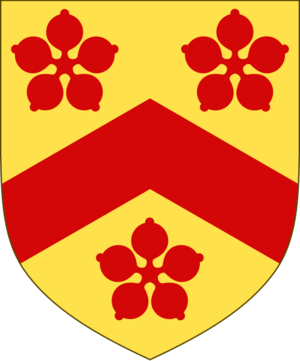Henry Chichele facts for kids
Quick facts for kids Henry Chichele |
|
|---|---|
| Archbishop of Canterbury Primate of All England |
|

19th-century imaginary portrait of Henry Chichele
|
|
| Church | Catholic Church |
| Appointed | 28 April 1414 |
| Reign ended | 12 April 1443 |
| Predecessor | Thomas Arundel |
| Successor | John Stafford |
| Other posts | Bishop of St Davids |
| Orders | |
| Consecration | 17 June 1408 by Gregory XII |
| Personal details | |
| Born | 1363 or 1364 |
| Died | 12 April 1443 |
| Coat of arms |  |

Henry Chichele (born around 1364 – died 12 April 1443) was a very important person in England. He served as the Archbishop of Canterbury from 1414 to 1443. He also started All Souls College, Oxford, a famous university college.
Contents
Early Life and Education
Henry Chichele was born in Higham Ferrers, Northamptonshire, England. This was around 1363 or 1364. His father, Thomas Chichele, was a mayor of Higham Ferrers several times. Henry's mother was Agnes Pincheon.
Henry went to New College, Oxford, a university in England. He started there in July 1387. He studied law and became a Bachelor of Arts (B.A.). He was also ordained as a sub-deacon, which is a step in becoming a priest.
A Career in Law and Royal Service
After university, Chichele moved to London. He became a lawyer in the main church court, called the Court of Arches. He quickly became successful.
To pay him for his work, he was given many church positions. For example, he became the parson of St Stephen Walbrook church in London. He also became the archdeacon of Dorset.
Working for the King
In 1405, Chichele began working for the King of England as a diplomat. A diplomat is someone who represents their country in other countries. His first mission was to meet the new Pope Innocent VII in Rome. The Pope wanted to end a big split in the church, called the Great Schism, where there were two popes at the same time.
In 1406, he went to Paris to try and make peace with France. He also tried to arrange a marriage between Prince Henry (who later became King Henry V) and a French princess.
Becoming a Bishop
In 1407, Chichele became the Bishop of St Davids in Wales. The Pope himself appointed him to this important role.
He continued his diplomatic work. In 1408, he went to Siena and then to the Council of Pisa in 1409. This council tried to solve the problem of having two popes. They ended up electing a third pope, which made things even more complicated!
Because he became a bishop, he had to give up some of his earlier church jobs. However, he made sure his family members, like his nephew William, got some of these positions.
In 1410, he went to France again to discuss peace. He also visited his new diocese in St Davids for the first time.
Archbishop of Canterbury
In 1414, King Henry V chose Henry Chichele to be the Archbishop of Canterbury. This is the most important church leader in England. He became archbishop shortly after the previous one died.
Some stories say that Chichele encouraged King Henry V to invade France. However, historical records show that the King had already decided to invade before Chichele became archbishop. Also, Chichele was not even present in the parliament where these discussions were supposed to have happened.
Dealing with Heresy
As archbishop, Chichele was very strict about church rules. He was known for persecuting people who had different religious beliefs, called Lollards. Lollards often questioned the wealth of the church and the power of priests.
For example, in 1420, a priest named William Taylor was burned at the stake. This happened because he said that people should pray only to God, not to saints.
Chichele also had disagreements with Henry Beaufort, the Bishop of Winchester. Beaufort wanted to become a cardinal and have more power than Chichele. Chichele fought against this, especially while King Henry V was alive.
Educational Foundations
Chichele is also remembered for starting new colleges. He wanted to help poor students and improve education.
He helped students at New College, Oxford, by providing money for them. He also founded three colleges:
- St Bernard's College, Oxford: Started in 1437 for Cistercian monks. It was later given to Christ Church, Oxford.
- Chichele College, Higham Ferrers: Founded in 1422 in his hometown. This college was for priests and clerks. It also had a school for grammar and singing. There was also an almshouse for twelve poor men.
- All Souls College, Oxford: This was his most famous foundation, started in 1438. It was for a warden and 20 scholars. He opened it shortly before he died.
Death and Burial
Henry Chichele died on 12 April 1443. He is buried in Canterbury Cathedral. His tomb is very detailed. It shows him as a grand archbishop on the top level, and as a skeleton on the lower level. This reminds people that everyone, even important leaders, will eventually die. The gate near his tomb is still called the "Chichele Gate."

See also
- Chichele Lectures
- Chichele Professorship




